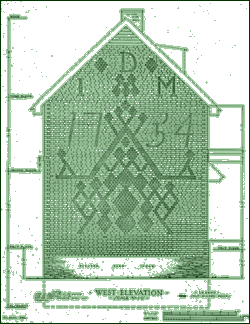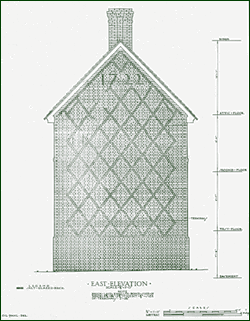 |
|
|||
Objectives Students will be able to:
Materials Pen and ink drawings of pattern end brick houses (as overheads or handouts) Pages 171–173 in Historic Themes and Resources Map of New Jersey indicating location of patterned brick houses from Peter O. Wacker Various art supplies Optional: Catalogs/circulars from a variety of building supply retailers Legos or other interlocking blocks
Through designing their own patterned end for their individual houses, students will realize the value of this architectural style/technique to the early settlers of the area. This activity will allow students to express their own "sense of place." Background Historic Themes and Resources pages 171-173 (Appendix 1) Pattern End Brick Houses — Leaving a Family Mark on the Landscape, by Bernard L. Herman, University of Delaware Excerpts from National Significance Statement — New Jersey Shore of Delaware Bay Period I (1670–1720): Formative Landscape Traditions The single colonial architectural tradition most closely associated with the Delsea study area is that of the pattern end brick houses erected from circa 1718 through the colonial period. The distinguishing characteristic of these dwellings is the use of glazed brick laid in intricate geometric patterns including chevrons, zigzags, and lozenges, along with construction dates and initial of the first occupants. The architectural significance of the pattern ended houses was first recognized in the 1880s when Thomas York, a local photographer and antiquarian, undertook what may be the earliest known historic architectural survey in the United States. York bound his large-format photographs and accompanying family histories into a large volume that remains in the collections of the Salem County Historical Society. The Historic American Buildings Survey recorded many of the pattern end houses as they stood in the 1930s. The pattern end houses of the Delsea study area are nationally significant as the architectural florescence of a regional building style without parallel in colonial America. The pattern end houses however, possess more than architectural significance. Procedure Warm Up The Activity
Wrap Up
Assessment The students’ individual pattern designs and renditions of their own houses, as well as a written description of them, is the assessment. Extensions Developing a budget for creating their pattern end house: Using the catalogs and building supply circulars, students actually measure and calculate the materials that would be needed to create their patterned end. Having a mason provide price quotes (estimated per hour charge, etc.) for students to include in their "budget" would be significant to a full understanding of the costs associated with these homes and why they represented the wealthiest people in the community. This activity would be suited as a homework/extended assignment that would also serve to involve the parents. Please download the PDF for the complete Lesson Plan.
Historic Themes and Resources, Appendix III, pages 177 through 180 Invite a local mason to be a guest speaker in the class. Visit the Hancock House, Hancock’s Bridge, and the Salem County Historical Society, Salem, for a firsthand look at these historically significant structures. The Salem County Historical Society at 79-83 Market Street, Salem, offers children’s programs. Call for more information and reservations (609) 935-5004 Possible applications available in computer programs that are utilized by builders and designers where students could design their patterns? Except for the Hancock House, the Woodstown and Salem Friends Meetinghouses* and the Alexander Grant House (the Salem County Historical Society’s headquarters) and the Gibbon House (Cumberland County Historical Society, Greenwich), all of the patterned brick homes are private property. Both the Grant House and the Gibbon House are pattern-brick structures, although not pattern end. They do, however, exhibit Flemish bond with glazed headers. The Salem County Historical Society, does, of course, welcome visitation. *Note: The two meetinghouses are interesting for comparative purposes — they include only the date of construction, but no initials, since these buildings belonged to the community, not any individual. Paving Stone Companies, Masons, etc. Check the telephone directory for a local listing. |
|||

 Classroom and home, as well as possible field trip
Classroom and home, as well as possible field trip  Making Connections
Making Connections